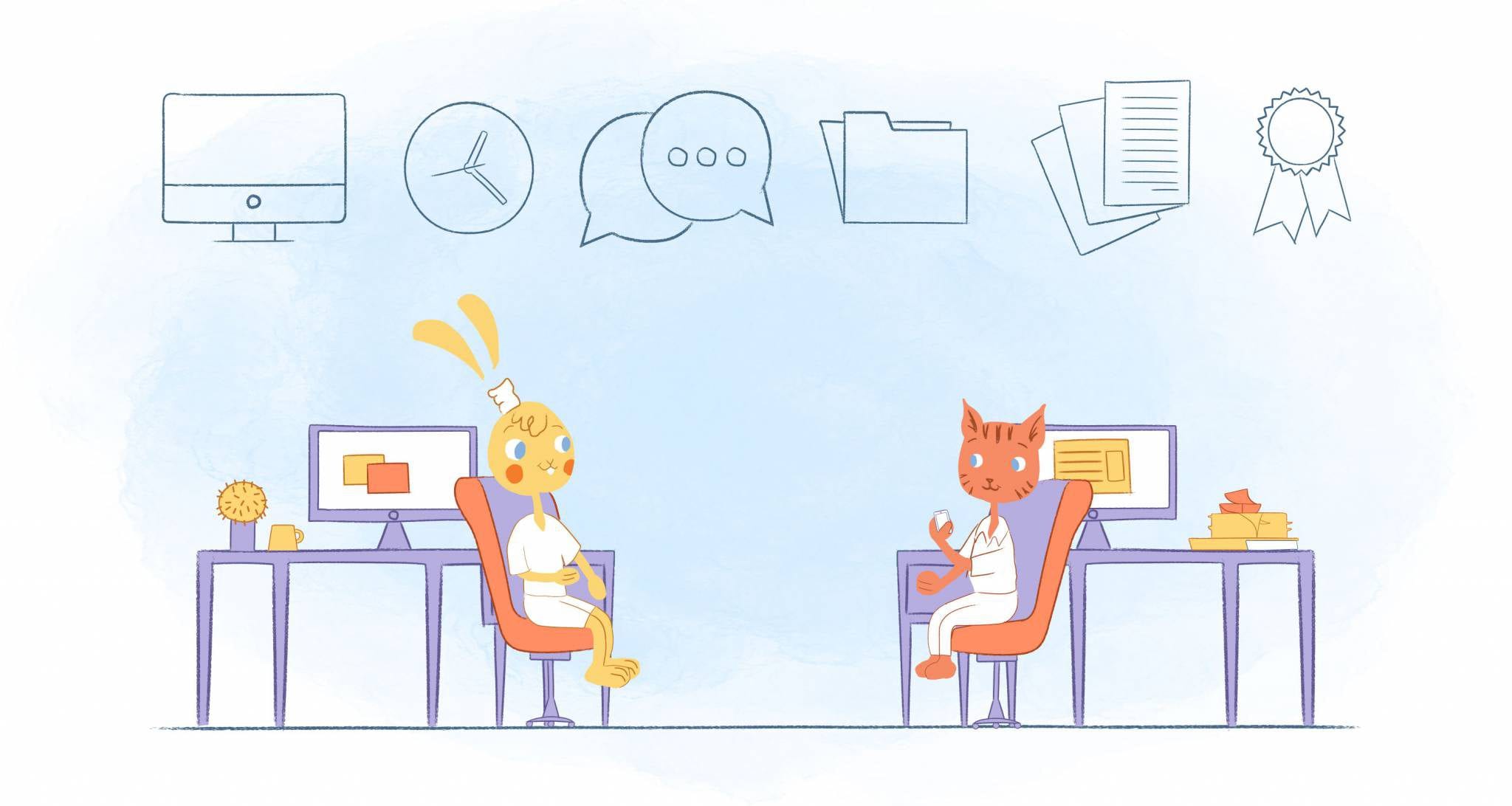

I don’t know what the reasoning was. But, I was on a David Bowie kick recently. As he was crooning “Ch-ch-ch-ch-changes (Turn and face the strange),” I thought how appropriate this was following COVID.
Everything has changed following the pandemic. Whether it’s from how we shop, communicate, and socialize. And, it’s certainly modified the workplace.
Hopefully, things will revert back to the world that we used to know. Until then, here’s how you can effectively manage the turbulency of change in your workspace in 2024.
Declare your change vision.
“The first step in well-known change management models is often to ‘create a sense of urgency,’” writes Sarah Jensen Clayton for HBR. “It’s safe to say that 2020 did that for us.”
“Depending on the change you are pursuing, you may be able to skip straight to declaring a change vision that outlines a compelling vision of your future state,” adds Clayton. These include “the principles and values that will guide your response,” as well as actionable steps. “While details are preferable in these types of statements, companies should be confident they can deliver on any stated commitments in the change vision.”
“Moving quickly will mean that not everyone will be able to weigh in,” says Clayton. And, your change vision will be far from perfect. “But it will make clear where you stand, put an end to any speculation and buy you time (though not much) to develop a plan.”
Moreover, if you don’t have a clear vision, you’ll be wasting precious time. Mainly this is because you’ll be “fielding stakeholder inquiries instead of tending to the necessary changes.”
Follow the 3 “C’s.”
Research from the Center for Creative Leadership has found that there are 3 skills needed to bridge the process and people parts of change. Once unified, your change initiative will be more likely to succeed.
So, what exactly are the 3 “C’s?” Well, they are;
- Communication. “Unsuccessful leaders tended to focus on the ‘what’ behind the change,” notes the CCL. “Successful leaders communicated the ‘what’ and the ‘why.’” Moreover, make sure that communication is clear, transparent, consistent, and purposeful. To make it easily accessible, use live streaming, video conferencing, and collaboration software like Slack and Zoom.
- Collaboration. “Bringing people together to plan and execute change is critical,” adds the CCL. “Successful leaders worked across boundaries, encouraged employees to break out of their silos, and refused to tolerate unhealthy competition.” They’ve also included team members during the decision-making process and solicited honest feedback. They also made themselves available to answer any questions or concerns.
- Commitment. “Change is difficult, but leaders who negotiated it successfully were resilient and persistent, and willing to step outside their comfort zone,” the CCL states. “They also devoted more of their own time to the change effort and focused on the big picture.”
Find key influencers.
There’s a trope in film and TV where a new teacher wins over the most popular student. Once they do, they have the attention and respect of the rest of the class. In a way, this is similar to commencing change in the workplace.
Identify your All-Stars and get them on board. Ideally, they should be those who are reliable, have longevity, and the admiration of their peers. As an ally, they can be an advocate for the change and sway others.
Additionally, they can serve as a type of middle person. For example, since they interact more frequently with the rest of your team, they bring issues to your attention. And, they can also help you communicate your change vision.
Lower stress and keep morale high.
“The mere mention of the word ‘change’ may cause some to feel uneasy,” writes Katherine Schreiber MFA, LMSW for Psychology Today. “We often find ourselves resisting change, perhaps because of the perceived risk or fear associated with it.”
To make this shift a little less difficult, eliminate as much stress as possible. And, while you’re at it, find ways to keep spirits high. Some ways to achieve this would be:
- Be aware that your employees may resist or panic over the new changes. As such, be empathetic to how they’re dealing.
- Actively listen to their questions, concerns, or feedback. Don’t forget to pay attention to their body language to pick-up on additional cues.
- Build trust with them by being competent and getting to know your team members. You can also achieve this by not micromanaging and leading by example.
- Cultivate a culture of psychological safety. You can do this by providing channels for them to speak freely without repercussion. Make sure that you also take action so that they know that their voices are being heard.
- Keep the mood light and encourage fun. Some ideas would be organizing a book club, having tournaments, celebrating birthdays/milestones, or throwing a pizza party.
Reduce change fatigue.
Gartner reports that change fatigue is higher than ever.
“The amount of change that the average employee can absorb without becoming fatigued is half what it was last year,” said Jessica Knight, Vice President, Gartner. “Employees’ ability to absorb change has plummeted precisely at the time when more organizations need change to reset.”
Why’s this concerning? Because change fatigue can manifest into negative reactions. These include burnout, frustration, and apathy. As a consequence, this can lower engagement and productivity.
“Change management must account for the small ripples of change in the organization,” said Knight. “Not just the Big Bang, because it turns out that those ripples actually take the greatest toll on employees.”
The goods news, you’ve already taken steps to help reduce change fatigue. Building trust is the first tactic. The second is ensuring that each team member has a sense of belonging.
Gartner states that the best technique, however, is focusing on how employees are experiencing change.
“Empowering different levels of leaders and teams to shape the change experience builds greater cohesion by enabling teams to define the desired experience for the changes they are implementing,” explains Knight. “It also builds trust among employees by supporting consistent delivery of that desired change experience.”
Follow through with plans but be flexible.
“Tenacity is key to adapting to change,” writes the folks at Robert Half. “Without commitment and determination, your team won’t get far in shifting to the ‘new normal’ you are asking them to embrace.”
“Remain firm in your goals and ensure that changes are implemented properly,” they add. That means “shifting to new processes and policies that may need to be instituted following a major change event.” If anything from your plan has been “ignored or left unfinished, it implies that those elements are not necessary, and employees will be less inclined to help make them a reality.”
“Given the above advice, the second part of this change management tip may seem counterintuitive.” While you must “follow through on plans, you also need to remain flexible,” they advise. “Be ready to alter your strategies, if necessary, to get past bumps in the road.”
And, most importantly, remind yourself and your team that this is a process. “And, to manage change in an organization effectively, you need to be prepared to take detours at times so that ultimately, your team can stay on course and reach the intended destination.”
Measure and analyze.
“Where a lot of change projects fail is the measurement piece,” Rachel Breitbach, the Change Management and Agility Practice Lead at Farwell, told Zendesk. As such, you need to have a system in place that informs you on whether you’ve achieved your goals or not. “If you don’t measure how something is going in the current state, they get a halo effect in terms of thinking it was working perfectly before the change,” Breitbach explains.
Which metrics and KPIs should you be paying attention to? Well, in a previous Zendesk article, these were;
- Employee readiness assessment results
- Employee engagement, buy-in, and participation measures
- Communication effectiveness
- Employee feedback
- Employee satisfaction survey results
- Training participation, tests, and effectiveness measures
- Usage and utilization reports
- Compliance and adherence reports
- Internal help desk metrics, such as tickets solved, tickets reopened, ticket escalations, issues by resolution area, as well as incidents and problems
- Observations of behavioral change
- Project KPI measurements
- Benefits realization and ROI
- Adherence to timeline
Just note that this should be done at every stage. That may seem like a ton of work. But, it ensures that you’re progressing and can put out flames before they become fires.
Image Credit: andrea piacquadio; pexels











John Rampton
John’s goal in life is to make people’s lives much more productive. Upping productivity allows us to spend more time doing the things we enjoy most. John was recently recognized by Entrepreneur Magazine as being one of the top marketers in the World. John is co-founder and CEO of Calendar.